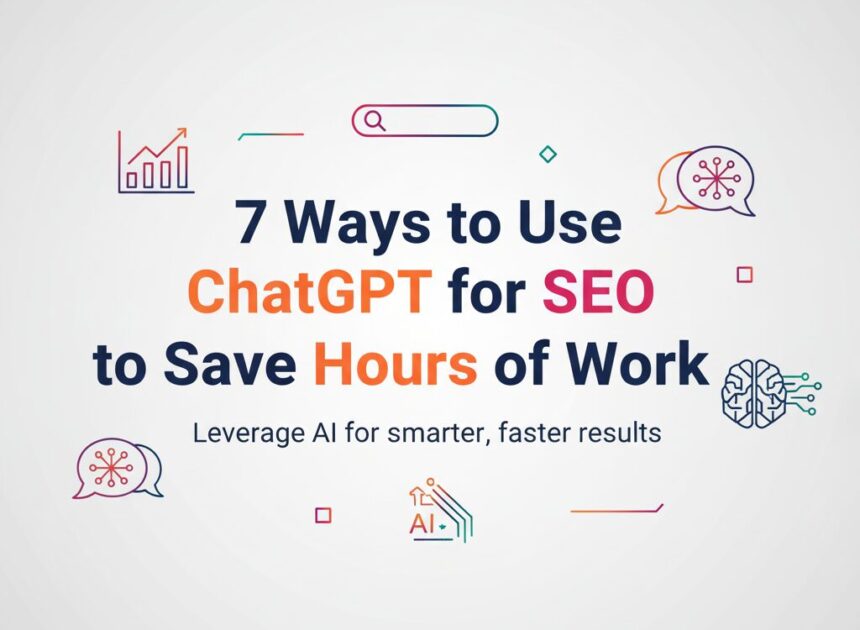Let’s be honest: the to-do list for a modern SEO professional is endless. From deep-diving into keyword data and structuring content to debugging technical issues and reporting on performance, the tasks keep piling up. It often feels like you need more hours in the day just to keep up, let alone get ahead. What if you could clone yourself?
While human cloning is still science fiction, an efficiency multiplier is already here. Artificial intelligence, specifically the powerful language models behind ChatGPT, is the single biggest opportunity for SEOs to reclaim their time and supercharge their results. Using ChatGPT for SEO isn’t about replacing strategy; it’s about automating the tedious and accelerating the creative.
This article will reveal 7 practical, game-changing ways you can leverage ChatGPT to automate repetitive tasks, generate brilliant ideas, and win back hours of your workweek in 2025.
1. Accelerate and Deepen Your Keyword Research
Keyword research is the bedrock of any successful SEO campaign, but it can be a real grind. ChatGPT can transform this process from a manual slog into a dynamic brainstorming session.
Brainstorming Seed Keywords and Topic Clusters
When you’re starting with a new client or exploring a new niche, coming up with foundational “seed” keywords can be tough. Instead of staring at a blank spreadsheet, you can use ChatGPT as your creative partner.
For example, if you’re working with a company that sells sustainable home goods, you could use a prompt like:
“Act as an SEO strategist. My client sells eco-friendly home goods online. Brainstorm 5 main topic clusters for their blog. For each cluster, provide 5-7 seed keyword ideas.”
In seconds, you’ll get a structured list of categories like “Zero-Waste Kitchen,” “Sustainable Cleaning,” and “Eco-Friendly Decor,” complete with starting keywords for each. This gives you a strategic foundation to build upon.
Uncovering Long-Tail Variations and Questions
The real gold in SEO often lies in long-tail keywords—longer, more specific phrases that indicate high user intent. These are less competitive and often convert better. Leveraging ai for keyword research is perfect for this.
Once you have a seed keyword like “sustainable cleaning products,” you can ask ChatGPT to expand on it:
“Given the core topic ‘sustainable cleaning products,’ generate a list of 20 long-tail keywords and common questions users might ask Google. Group them by user intent.”
This prompt will instantly give you a list of valuable phrases like “best non-toxic all-purpose cleaner for families” or “how to make your own sustainable disinfectant spray,” which you can target with specific blog posts or FAQ sections.
Using AI for Keyword Research and Intent Classification
Understanding user intent—what a searcher actually wants to achieve—is critical. Manually sorting a list of 500 keywords into informational, commercial, transactional, and navigational buckets can take hours. ChatGPT can do it in minutes.
Simply paste your list of keywords and use a prompt like this:
“Here is a list of keywords. Classify each one by its most likely user intent: Informational (learning something), Commercial (researching before a purchase), Transactional (ready to buy), or Navigational (finding a specific site). Present the output in a table with two columns: Keyword and Intent.”
This automation not only saves time but also helps you plan your content strategy more effectively, ensuring you create the right type of content for each stage of the user journey.
2. Craft Comprehensive Content Outlines in Minutes
A great piece of content starts with a great outline. ChatGPT can help you build a robust, SEO-friendly structure that sets your writers up for success and ensures your content covers a topic comprehensively.
Generating an Initial Blog Post Structure
Staring at a blank page is intimidating. With a target keyword in mind, you can ask ChatGPT to build the skeleton of your article.
Prompt example:
“Create a detailed blog post outline for the target keyword ‘how to start a container garden.’ The outline should have a logical flow, including an introduction, H2s for main sections, and H3s for sub-points. Focus on answering key questions a beginner would have.”
This will give you a well-organized structure you can then refine, ensuring all critical subtopics are covered from the get-go.
Creating In-Depth AI Content Briefs for Writers
A clear brief is the difference between good and great content. Using ai content briefs generated by ChatGPT ensures nothing is missed. You can ask it to create a comprehensive document for your writers.
A powerful prompt for this would be:
“Create a complete content brief for an article titled ‘The Ultimate Guide to Container Gardening for Beginners.’ Include the following:
- Target Audience: Beginners living in apartments with limited space.
- Primary Keyword: ‘how to start a container garden’.
- Secondary Keywords: ‘best plants for container gardening,’ ‘container gardening soil mix,’ ‘balcony vegetable garden.’
- Key Questions to Answer: What is container gardening? What supplies are needed? How do you choose the right pot? What are the easiest vegetables to grow?
- Internal Linking Suggestions: Suggest linking to existing articles on ‘DIY Potting Soil’ and ‘Small-Space Composting.’
- Related Entities to Include: Mention concepts like drainage, sunlight requirements, fertilizer, and companion planting.”
This detailed brief gives your writer everything they need to produce a high-ranking, valuable piece of content.
Ideating for FAQs and “People Also Ask” Sections
Google loves to see content that directly answers user questions. Including an FAQ section is a great way to capture “People Also Ask” (PAA) boxes and featured snippets. ChatGPT can predict what your audience is curious about.
Prompt:
“For the topic ‘container gardening,’ generate a list of 10-12 frequently asked questions that would be suitable for an FAQ section at the end of a blog post.”
3. Streamline On-Page SEO and Meta Data Creation
On-page SEO involves many small but crucial tasks. ChatGPT can handle the repetitive work of writing metadata, allowing you to focus on higher-level strategy.
How to Write Meta Descriptions with AI That Get Clicks
Writing a compelling meta description that’s under 160 characters and includes the keyword can be tricky. This is a perfect task to write meta descriptions with ai.
Prompt:
“Write 3 unique meta descriptions for a blog post titled ‘7 Easy Steps to Start a Container Garden.’ The primary keyword is ‘how to start a container garden.’ The tone should be encouraging and helpful. Keep it under 155 characters and include a call to action.”
You’ll get several options to choose from, all optimized for length and click-through rate.
Generating Multiple Title Tag and H1 Variations
Your headline is your first impression. A/B testing different titles can significantly impact traffic. Instead of agonizing over the perfect one, generate several strong options instantly.
Prompt:
“Generate 5 creative and SEO-optimized title tag ideas for a blog post about starting a container garden. The titles should be compelling and under 60 characters.”
Writing Alt Text and Image Descriptions at Scale
Alt text is essential for accessibility and image SEO, but writing it for every image in a long article is tedious. ChatGPT can automate this.
Prompt:
“Write a descriptive and SEO-friendly alt text for an image showing a person planting a tomato seedling in a terracotta pot on a sunny balcony. Include the keyword ‘container gardening’.”
4. Simplify Technical SEO Tasks
Technical SEO can be intimidating, especially when it involves code. ChatGPT can act as your technical translator, generating the code and directives you need from plain English instructions.
Generating Schema Markup Code
Schema markup helps search engines understand your content better, leading to rich results like FAQs and How-Tos in the SERPs. You don’t need to be a developer to create it.
Prompt:
“Generate JSON-LD schema markup for an FAQ page with the following three questions and answers:
- Q1: What is the best soil for container gardening?
- A1: A high-quality potting mix is best…
- Q2: How often should I water my container plants?
- A2: It depends on the plant, pot size, and weather…”
ChatGPT will provide the error-free code that you can copy and paste directly into your site.
Creating Robots.txt and .htaccess Rules
Need to block a search engine bot from crawling a staging site or set up a 301 redirect? These tasks often require precise syntax in files like robots.txt or .htaccess.
Prompt:
“Generate the robots.txt rule to disallow Googlebot from crawling the /private/ directory on my website.”
Or for a redirect:
“Generate the .htaccess code for a 301 redirect from mysite.com/old-page to mysite.com/new-page.”
Building an Internal Linking Strategy
Internal linking is crucial for distributing page authority and helping Google understand your site structure. ChatGPT can analyze your content and suggest relevant linking opportunities.
Prompt:
“I have a new blog post about ‘The Benefits of Drip Irrigation for Container Gardens.’ Here is a list of my existing blog posts and their URLs: [Paste a list of your relevant posts and URLs]. Please read the text of my new post [Paste the text of the new post] and suggest 3-5 relevant internal linking opportunities from the list provided, including the anchor text you would use.”
5. Supercharge Your Link Building and Outreach
Link building requires creativity and persistence. ChatGPT can be your brainstorming partner for creating link-worthy assets and your assistant for managing outreach.
Brainstorming Link-Worthy “Link Bait” Ideas
The best links are earned, not just built. This requires creating “link bait”—content so valuable that other sites naturally want to link to it.
Prompt:
“Act as a digital PR strategist. Brainstorm 5 link-worthy content ideas for a blog focused on sustainable living. The ideas should be unique and likely to attract backlinks from news sites and environmental blogs. Think about data studies, interactive tools, or ultimate guides.”
Prospecting for Relevant Outreach Targets
Once you have your amazing content, you need to find the right people to share it with.
Prompt:
“Create a list of 10 types of websites or blogs that would be interested in an article about ‘The Environmental Impact of Fast Fashion.’ For each type, suggest 3 specific search queries I could use in Google to find them.”
Drafting Personalized Outreach Email Templates
Generic outreach emails get deleted. Personalization is key. ChatGPT can help you create a strong template that you can easily customize for each prospect.
Prompt:
“Write a personalized outreach email template for link building. The email should be concise, friendly, and focus on providing value. It needs to compliment a specific piece of their content and then briefly introduce my new resource on [Your Topic], explaining why it would be a good fit for their audience. Include placeholders like [Their Name], [Their Article Title], and [Your Resource Link] for easy customization.”
6. Enhance Your Local SEO Efforts
For businesses serving a specific geographic area, local SEO is paramount. ChatGPT can help you optimize your most important local asset: your Google Business Profile (GBP).
Optimizing Google Business Profile Descriptions
Your GBP description is prime real estate. It needs to be compelling for customers and optimized for local search terms.
Prompt:
“Write a 750-character Google Business Profile description for a family-owned Italian restaurant in San Francisco called ‘Mama Rosa’s.’ Mention that we specialize in homemade pasta, use local ingredients, and have a dog-friendly patio. Include keywords like ‘Italian restaurant San Francisco,’ ‘homemade pasta,’ and ‘best Italian food in North Beach’.”
Generating Content for GBP Posts and Q&As
Keeping your GBP active with posts and a populated Q&A section signals to Google that your business is active and engaged.
Prompt:
“Generate 5 short Google Business Profile post ideas for ‘Mama Rosa’s’ Italian restaurant. Ideas could include a weekly special, a staff spotlight, or a holiday promotion. Also, create a list of 5 common questions and their answers for the GBP Q&A section.”
7. Automate Data Interpretation and Reporting
Sifting through mountains of data in Google Analytics and Search Console can be overwhelming. ChatGPT can act as your data analyst, pulling out the most important insights in seconds.
Summarizing Performance Data
Instead of spending hours trying to spot trends in a spreadsheet, let AI do the heavy lifting.
Prompt:
“I’m pasting my Google Search Console performance data for the last 30 days, showing clicks and impressions by query. [Paste your data]. Please analyze this data and provide a summary in plain English that identifies:
- Top 3 performing queries.
- Any queries with high impressions but low clicks (potential optimization opportunities).
- Any noticeable upward or downward trends.”
Writing Client-Friendly Report Summaries
Clients and stakeholders don’t want to see raw data; they want to know what it means. ChatGPT can translate your metrics into a clear, concise executive summary.
Prompt:
“Based on the following data points: organic traffic is up 15% month-over-month, we now rank #3 for ‘best seo agency new york,’ and our blog post on ‘AI for SEO’ generated 5 new leads. Write a short, positive executive summary for a client report that explains these results and their business impact.”
The Future is Efficient
The scope of an SEO’s role is only getting broader. The seven strategies outlined here are just the beginning of how you can use ChatGPT for SEO to work smarter, not just harder. From accelerating your initial research and building better ai content briefs to simplifying technical SEO and streamlining outreach, AI is your partner in efficiency.
Adopting these techniques is no longer a novelty; it’s a necessity for staying competitive and innovative in the SEO landscape of 2025 and beyond. By letting AI handle the repetitive tasks, you free yourself up to focus on what truly matters: strategy, creativity, and driving meaningful results.Ready to see how innovative SEO strategies and cutting-edge tools can transform your business? Contact us.







